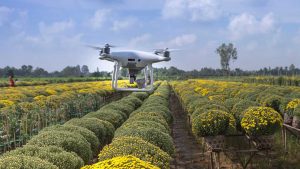
If you’re like me, you may sometimes wonder if the English language has been reduced to words containing only 3-4 letters. We often see it in almost every industry we’ve encountered in our professional lives.
What am I talking about?
Acronyms.

Drone Flying Over Vegetation
For those of us in the drone industry, it’s no different. In fact, given the relatively early stage of our industry’s evolution, it can be quite daunting to keep up with the latest drone industry acronyms. You’re probably saying, here comes yet another 3 letter word I have to learn. OMG!
Well, I thought it would be a great idea to gather a few of the most common drone industry acronyms and provide a definition for each.
Without further ado, here are my Top 15 Most Common Drone Industry Acronyms (in alphabetical order):
AGL – Above Ground Level: In aviation, the term AGL generally refers to the height of an object above ground level. As it relates to Part 107, a drone pilot cannot fly an sUAS (see below) higher than 400 feet Above Ground Level. The only exception to that rule is if the drone is flown within a 400-foot radius of a structure and does not fly higher than 400 feet above the highest, permanently attached, point of the structure.
ATC – Air Traffic Control: is a service provided by ground-based air traffic controllers to direct aircraft on the ground and through controlled airspace and can provide advisory services to aircraft in non-controlled airspace. The primary purpose of ATC worldwide is to prevent collisions, organize and expedite the flow of air traffic, and provide information and other support for pilots.
BVLOS – Beyond Visual Line of Site: BVLOS is a term relating to the operation of UAVs (unmanned aerial vehicles) and drones at distances outside the normal visible range of the pilot.
COTS – Commercial Off the Shelf (Drone): COTS is an acronym that refers to commercially available drones but is more recently associated with a COTs drones’ inter-operability with “Drone-in-the-Box” remote charging solutions for BVLOS applications. The industry is collectively working towards developing charging solutions that are drone manufacturer agnostic and can be used to charge a variety of popular commercially available off-the-shelf drones.
eVTOL – electric Vertical Take-Off & Landing: eVTOL is a type of aircraft that uses electric power to hover, take off, and land vertically. In the drone industry, eVTOL is often associated with metropolitan airbus transportation and UAM (see below).
FAA – Federal Aviation Administration: The Federal Aviation Administration is the largest modern transportation agency and a governmental body of the United States with powers to regulate all aspects of civil aviation in that nation as well as over its surrounding international waters.
NAS – National Air Space: The NAS is airspace that is regulated by the FAA and can be either controlled or uncontrolled airspace.
NTSB – National Transportation Safety Board: The NTSB is an independent U.S. government investigative agency responsible for civil transportation safety and accident investigation.
OAS – Obstacle Avoidance System: An integral on-board software and optical system that enables unmanned drones to “see and avoid” obstacles to minimize mid-air collisions. You will often hear OAS mentioned in conjunction with BVLOS as it is a critical function to enable safe autonomous flight planning initiatives.
sUAS – Small Unmanned Aircraft System: Similar to UAS, there are many terms for UAS technology such as Drone, Unmanned Aerial Vehicle (UAV), Unmanned Aircraft (UA), Unmanned Aircraft System (UAS) and small Unmanned Aircraft System (sUAS). These acronyms are often used interchangeably in industry circles.
UA – Unmanned aircraft: this term refers to drones, or any aircraft, that are designed to operate autonomously or to be piloted remotely without a pilot on board.
UAM – Urban Air Mobility: UAM refers to air traffic systems that are designed to transport people by air. Unlike modern airspace rules that guide commercial aircraft at higher altitudes, UAM is designed for commercial eVTOL air transportation at lower altitudes within urban and suburban areas.
UAS – Unmanned Aircraft System: Unmanned aircraft system (UAS) typically refers to an unmanned drone and its related equipment that enables a remote operator to allow the drone to operate autonomously.
UATM – Urban Air Traffic Management: Often referred to in connection to UTM (see below), Urban Air Traffic Management represents a highly coordinated system of urban air traffic management for autonomous drones.
UTM – Unmanned Traffic Management: Unmanned Aircraft System Traffic Management (UTM) is an air traffic management ecosystem that creates defined “rules of the road” for uncontrolled airspace below 400 feet AGL.
Clearly, I have only touched the surface of the acronyms you will see in our industry. As the drone industry continues to evolve, there will no doubt be more to come! If you feel I have missed an important one, hit us up on Social Media and let us know what you think (Twitter, Facebook, Instagram).
From The Editor:
Do you need to hire a professional drone service provider? To speak to an aerial data specialist, fill out a form, email us or for even faster response times, give us a call at (833) FLY-4YOU or (833) 359-4968. Check out our transparent pricing at Drone Photography Pricing and watch this space as we expand on the above topics and more over the coming weeks and months. If you like this post, feel free to click the share button at the bottom of the page. We appreciate you helping us by spreading the content we share on our blog.
- Drones and Construction – The 2025 Outlook - February 8, 2025
- The Future of Business: Top 7 Commercial Drone Applications Across Key Sectors - January 19, 2025
- From Over-Ordering to Supplier Accountability: How Drones Redefine Stockpile Management - January 12, 2025

